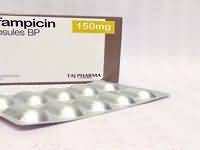Fluphenazine

Fluphenazine
CLINICAL USE
Antipsychotic:Mania, schizophrenia and other psychoses Short-term use for anxiety, psychomotor agitation, excitement and violent or dangerously impulsive behaviour
DOSE IN NORMAL RENAL FUNCTION
Oral:Mania, schizophrenia and other psychoses: 2–20 mg daily in 2–3 divided dosesShort-term use for anxiety, psychomotor agitation, excitement and violent or dangerously impulsive behaviour: 1–2 mg twice dailyDeep IM:Schizophrenia and other psychoses: 12.5– 100 mg every 14–35 days
PHARMACOKINETICS
Molecular weight :437.5, 510.4 (as hydrochloride), (591.8 as decanoate) %Protein binding :>90 %Excreted unchanged in urine : 20 Volume of distribution (L/kg) :10half-life – normal/ESRD (hrs) :14.7 (6–9 days after IM) DOSE IN RENAL IMPAIRMENT
GFR (mL/MIN)
20 to 50 : Dose as in normal renal function 10 to 20 : Dose as in normal renal function <10 : Start with a low dose and titrate slowly DOSE IN PATIENTS UNDERGOING RENAL REPLACEMENT THERAPIES
CAPD :Not dialysed. Dose as in GFR <10 mL/min HD :Not dialysed. Dose as in GFR <10 mL/min HDF/high flux :Unknown dialysability. Dose as in GFR <10 mL/minCAV/VVHD :Unknown dialysability. Dose as in normal renal function IMPORTANT DRUG INTERACTIONS
Potentially hazardous interactions with other drugs Anaesthetics: enhanced hypotensive effect Analgesics: increased risk of convulsions with tramadol; enhanced hypotensive and sedative effects with opioidsAnti-arrhythmics: increased risk of ventricular arrhythmias with anti-arrhythmics that prolong the QT interval; avoid concomitant use with amiodaroneAntibacterials: increased risk of ventricular arrhythmias with moxifloxacin – avoid concomitant useAntidepressants: increased plasma level of tricyclics; possibly increased risk of ventricular arrhythmias and antimuscarinic side effectsAnticonvulsant: antagonises anticonvulsant effectAntimalarials: avoid concomitant use with artemether/lumefantrineAntipsychotics: increased risk of ventricular arrhythmias with pimozide – avoid concomitant use; avoid concomitant use of depot formulations with clozapine (cannot be withdrawn quickly if neutropenia occurs)Antivirals: concentration possibly increased with ritonavirAnxiolytics and hypnotics: increased sedative effectsBeta-blockers: enhanced hypotensive effect; increased risk of ventricular arrhythmias with sotalol Diuretics: enhanced hypotensive effect Lithium: increased risk of extrapyramidal side effects and possibly neurotoxicity Pentamidine: increased risk of ventricular arrhythmiasSibutramine: increased risk of CNS toxicity – avoid concomitant useAvoid concomitant use with drugs that prolong the QT interval ADMINISTRATION
Reconstition
– Route
Oral, IM Rate of Administration
–Comments
See how to identify renal failure stages according to GFR calculation
See how to diagnose irreversible renal disease
Home









